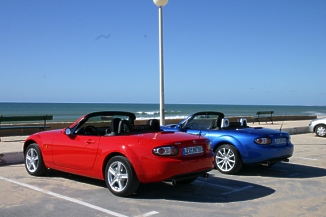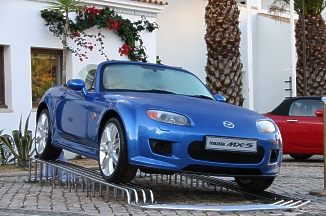
.
November 09, 2005
.
This Week:
-
New Saab 9-5 Makes North American Debut at New England International Auto Show
-
Positive Sales Development Continues at the Mercedes Car Group in October
-
BMW Group's Chris Bangle Will Open Design Los Angeles Conference at LA Auto Show
-
DaimlerChrysler Is First Company to Provide Vehicle Financing for Both Cars and Trucks in China
-
Toyota Hits Milestone of Ten Million Engines Produced in North America
© 1998
- 2005 Copyright &
Disclaimer
Automotive Intelligence,
www.autointell.com
All Rights Reserved .
For questions please contact
editor@autointell.net
|
.
On February 9, 1989, Mazda unveiled the MX-5 (Miata) at the Chicago Motor Show and made history by initiating a rebirth of the lightweight roadster segment, written off as dead prior to that date. Since then, Mazda has never stopped refining the classic concept of its affordable, rear-wheel drive two-seater. By 2000, the Mazda MX-5 was entered into the Guinness Book of World Records as the most successful open two-seater sports car of all time. Since then, demand has remained high and Mazda has produced nearly 725,000 units to date. Now the third-generation Mazda MX-5 is coming to Europe with market launch set for November 2005. The new Mazda MX-5 is still an affordable, fun to drive roadster with harmonious proportions and no unnecessary frills. When you first see the new car, it is still clearly recognisable as a Mazda MX-5. Compared to the preceding model, however, the new Mazda MX-5 has the athletic build of a true sports car.
|
|
The practical advantage of this new exterior design is a wider cockpit with more hip, shoulder and elbow room, and space to fit side airbags for the first time. Thanks to the 65 mm longer wheelbase, people as tall as 1.86 m can comfortably fit into the car – in the past, it was a bit cramped for people over 1.80 m tall.
Soft Top can be Opened with One Hand in Only Six Seconds

Photo: Automotive Intelligence
The soft top is made of high quality material and can be opened and closed by using a centrally-placed latch in just six seconds and using only one hand. The Z-fold soft top, when completely folded back, sits flush with the boot lid, which does away with the need for a tonneau cover. And you don’t even have to get out of the car to open or close the top.
For the inside, MX-5 designers sought to create a higher quality feel, as well as combining new materials. Mazda MX-5’s solid quality finish is achieved by using decorative piano black embellishments and quality detailing on features such as the driving instruments, whose needles seem to twitch inanticipation of the driving enjoyment to come when the car’s ignition is switched on.
The ‘open mode’ function of the ventilation system uses additional air vents on both sides of the centre stack and in the foot well, along with the instrument panel vents and defrost vents to blow cold or warm air directly onto the parts of the occupants most affected by weather.
This new feature extends Mazda MX-5’s open-air season considerably. While the preceding model was comfortable to drive in temperatures between 15 and 25° C, now you can drive the new Mazda MX-5 comfortably in air temperatures from 10 to 30° C. Quarter windows placed at the bottoms of the A-pillars, along with a new, more efficient aero board wind-blocker, make driving with the top down even more comfortable.
Mazda has given the latest MX-5 two new engines from the MZR petrol family, a 2.0-litre four-cylinder and – only for Europe –a 1.8-litre unit. Both engines meet Euro Stage IV emission standards and are mounted longitudinally under the bonnet. Both are lightweight and compact, with chain-driven, double overhead camshafts, four valves per cylinder, sequential inlet-valve timing (2.0-litre engine) and variable intake-air systems (VIS). The cylinder block and head, as well as the oil pan sump, are made of aluminium.
The MZR 2.0-litre engine produces a maximum of 118 kW/160 PS of power at 6,700 rpm and generates maximum torque of 188 Nm at 5,000 rpm. Even more important: between 2,500 and 6,700 rpm, a minimum of 90 percent of engine torque is always available. The Mazda MX-5 with a 2.0-litre engine has a top speed of 210 km/h (130 mph).
The MZR 1.8-litre engine produces a maximum of 93 kW/126 PS of power at 6,500 rpm and 167 Nm of torque at 4,500 rpm. This entry-level model has a top speed of 196 km/h (122 mph).
Manual Five-Speed and Six-Speed Transmissions Just As Precise-Shifting As Ever
The manual transmission mated to the MZR 1.8-litre engine is an enhanced version of the five-speed transmission of the previous Mazda MX-5 model. For the MZR 2.0-litre engine there is a newly developed six-speed manual transmission that features even shorter shift travel with especially low-effort shifting.
As was the case with the outgoing model, the new Mazda MX-5 has a powerplant frame made of pressed aluminium in the transmission tunnel. This frame rigidly connects the transmission and the rear axle differential, to brace the chassis and suppress chassis flex during heavy acceleration. This feature, which functions like a strong backbone, has also been applied in a similar way to the outgoing model and to the Mazda RX-8, which is built on the same assembly lines with the new Mazda MX-5 in Japan.
(Nov. 4, 2005)
| .
Homepage News Companies Management Publications Events Guestbook Search . |
